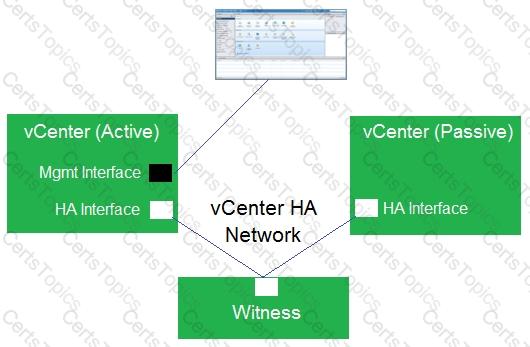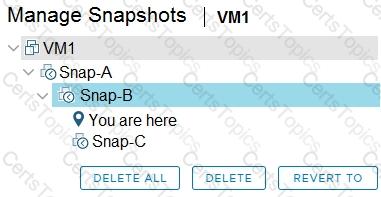An administrator places a 300 GB virtual machine named “Finance1” on a 2 TB datastore containing other virtual machines. After virtual machine placement, the datastore has 200 GB of free space. The accounting department takes a nightly snapshot of Finance1, then deletes the previous snapshot. The administrator is concerned about snapshots filling the datastore.
Which statement is true regarding snapshots? (Choose the best answer.)
An administrator is asked to take a snapshot of a virtual machine prior to an application upgrade. The virtual machine has one standard virtual machine disk (VMDK) and one physical mode raw device mapping (RDM) attached.
Which statement is true with regard to taking this snapshot? (Choose the best answer.)
Refer to the exhibit.

Which element is missing from this vCenter High Availability (HA) cluster? (Choose the best answer.)
What is a requirement of Storage I/O Control? (Choose the best answer.)
An administrator wants to implement virtual machine encryption.
Which component encrypts the virtual machine files? (Choose the best answer.)
A host profile is updated with a new password that urgently needs to be changed on all hosts attached to the host profile.
Which option would an administrator select to complete the password change? (Choose the best answer.)
Which vSphere feature provides for continuous local data center availability? (Choose the best answer.)
What are two supported ESXi boot options? (Choose two.)
Which two vSphere features enable remote site availability? (Choose two.)
Refer to the exhibit.

Which two statements are true regarding the state of the virtual machine (VM) if an administrator clicks the “Delete All” option? (Choose two.)
How does vSphere handle memory allocation during the instant clone process? (Choose the best answer.)
vCenter High Availability (HA) protects vCenter Server against host and hardware failures.
What is the minimum number of ESXi hosts required to enable this capability? (Choose the best answer.)
An administrator is NOT able to enable ESXi secure boot.
What is a possible cause of this issue? (Choose the best answer.)
A vSphere environment is configured with 1 Gigabit Ethernet for vSphere vMotion. The application team is complaining that when they try to migrate a powered-on virtual machine, the progress is slow and unsuccessful the majority of the time.
Which two recommendations should the administrator make to improve vSphere vMotion performance? (Choose two.)
In a vSphere High Availability (vSphere HA) cluster, which condition can be detected by datastore heartbeating? (Choose the best answer.)
An administrator runs a two-node vSphere cluster, which contains two domain controller virtual machines (VMs). The administrator wants to ensure that VMs run on separate hosts without interfering with normal maintenance operations.
How should the administrator configure Distributed Resource Scheduler (DRS)? (Choose the best answer.)